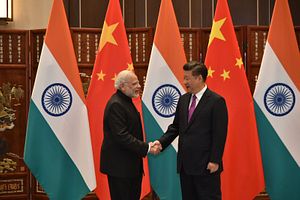The Indian government is exploring the possibility of restricting the import of electronics and information technology products from China. Ostensibly, the reason is to bolster security and prevent data leakages. However, the immediate provocation for reviewing its trade agreement with China was the India-China standoff at the Doklam plateau.
As both the countries have now agreed to deescalate the tension by withdrawing their troops, India could now turn to trade issues with China, with the aim of correcting the present one-way trade, where China continues to be the beneficiary because of its protectionist policies.
Although trade is skewed heavily in favor of China, any move to put a restriction on the import of Chinese goods will hit Indian industries hard, as India imports over $22 million in cheap electronics and information technology products for its own electronics and power sectors.
Chinese media had recently criticized India for imposing anti-dumping duties on more than 93 Chinese products. The anti-dumping duties on chemicals and machinery items imported from China have already been in place for some time. Other Chinese products on which India has imposed anti-dumping duties include steel and other metals, fibers and yarn, rubber or plastic, electronics, and consumer goods.
The logic behind imposing anti-dumping duties is mainly to protect domestic industries, as they are not able to match the price of cheap Chinese products. Anti-dumping duties aim to create a level playing field for Indian manufacturers.
Yet any step to impose unreasonable restrictions of imports from China would amount to a contravention of the World Trade Organization’s laws. Secondly, as local manufacturing companies in India are not geared up to supply goods to the rising power and telecom sectors, India may be forced to import such good from the United States and Europe at a prohibitive cost, which may put an additional financial burden on these two sectors.
Today, China is India’s largest trading partner, with a bilateral trade of $71.5 billion. The total imports from China during the last fiscal year stood at $61.3 billion against India’s export to China worth $10.2 billion. The trade deficit, which stood at $37.2 billion a few years ago, now stands at a whopping $51.1 billion.
One of the main reasons for this unfavorable trade balance is that India exports only raw materials like iron ore and copper to China. The deficit can be reduced only when India starts exporting value-added products. Unfortunately, the Indian manufacturing industries have to go a long way before they are geared up to export value-added products to China.
India is one of the largest manufacturers of generic drugs. But it has not been able to export to China because of Beijing’s protectionist policies. While Indian pharmaceutical companies exporting generic drugs to the United States and Europe, as most of the drugs have received FDA and EU approval, it is quite striking that China does not allow imports of drugs from India.
Indian pharmaceutical companies have taken up the issue with the Indian Commerce Ministry to facilitate export of generic drugs to China, especially since a Chinese delegation completed inspections of their manufacturing facilities a year ago. The Indian Commerce and Industry Minister has also taken up the matter with his Chinese counterpart in this regard.
Healthy trade between two countries has the potential to reduce tensions. The leaders of both the countries have so far shown flexibility in improving relations. India should reconsider imposing restrictions on Chinese goods, as it has the potential to aggravate an already fragile status quo. China, on its part, should help India reduce the trade deficit by importing generic drugs and IT enabled services.
Chinese companies have huge investments in the cell phone business, telecom, and power sectors. Such goods have become the backbone of India’s own manufacturing. One of the reasons for the popularity of Chinese goods is that they are cheap, compared to locally manufactured goods, as well as comparable imports from the United States or other Western countries.
If India decides to put an embargo on Chinese goods, and decides to import from other countries, it would involve a huge cost escalation which would translate into rising costs of goods and services, such as power generation. Similarly, the telecom and IT industries, which depend on import of hardware from China, will also be affected.
Despite the Indian prime minister’s “Make in India” initiative, India is finding it difficult to increase its manufacturing capabilities in a short time span. Until India is able to create a sound manufacturing base, it should refrain from imposing any unreasonable restrictions on Chinese goods, as it would stand to suffer more than China. It must be mentioned here that the Chinese exports to India account for only two percent of its overall exports. In case of any boycott of Chinese products, it is the Indian manufacturing companies that will be hit the most.
Both the Chinese president and the Indian prime minister are known for their mature leadership and gravitas. Both should immediately engage in a dialogue to defuse the tension between the two countries. The BRICS forum scheduled in September in China would be the ideal platform for both the leaders to address the trade imbalance.
K.S. Venkatachalam is an independent columnist and political commentator.

































